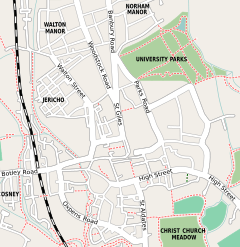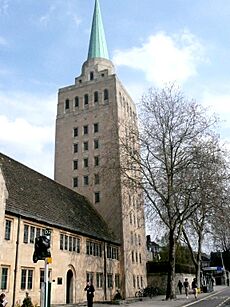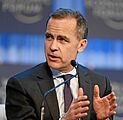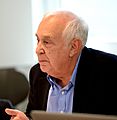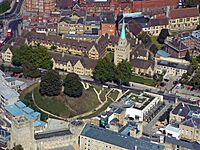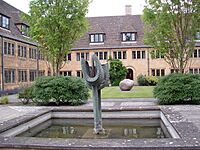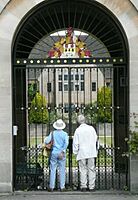Nuffield College, Oxford facts for kids
Quick facts for kids Nuffield College |
||||||||||||||
|---|---|---|---|---|---|---|---|---|---|---|---|---|---|---|
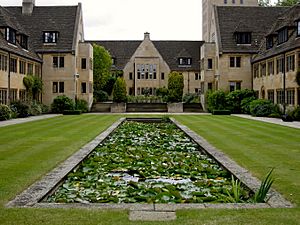
Nuffield College Courtyard, from the west
|
||||||||||||||
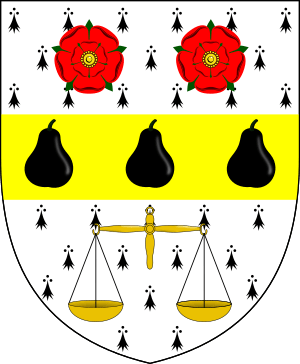
Blazon: Ermine on a fesse or between in chief two roses gules barbed and seeded proper and in base a balance of the second three pears sable. The Crest was slightly moderated and redrawn to simplify the design in Summer 2017.
|
||||||||||||||
|
|
||||||||||||||
| University | University of Oxford | |||||||||||||
| Location | New Road and Worcester Street | |||||||||||||
| Coordinates | 51°45′10″N 1°15′47″W / 51.752834°N 1.262917°W | |||||||||||||
| Full name | Nuffield College in the University of Oxford | |||||||||||||
| Latin name | Collegium Nuffield | |||||||||||||
| Motto | Fiat Justitia | |||||||||||||
| Established | 1937 | |||||||||||||
| Named for | William Morris, 1st Viscount Nuffield | |||||||||||||
| Architect | Austen Harrison | |||||||||||||
| Sister college | None | |||||||||||||
| Warden | Sir Andrew Dilnot | |||||||||||||
| Undergraduates | None | |||||||||||||
| Postgraduates | 90 | |||||||||||||
| Map | ||||||||||||||
Nuffield College is one of the colleges that make up the University of Oxford in England. It is a special college for students who are studying for advanced degrees (graduates). It focuses on social sciences like economics, politics, and sociology.
Nuffield is one of Oxford's newer colleges, started in 1937. It is also one of the smallest, with about 90 students and 60 academic staff members called fellows. It was the first Oxford college to welcome both men and women. It was also the first college in Oxford or Cambridge just for graduate students.
In 2021, the college had about £282 million in funding. Because it has few students, it was one of the richest schools per student in the world in 2013. Since 2017, Nuffield has promised to pay for all new students accepted there. Between 2019 and 2023, about 5% of people who applied were accepted.
The college's buildings look like traditional Oxford colleges. Its modern tower is a well-known sight for people coming into Oxford from the west.
Contents
History
Nuffield College was started in 1937. This happened after Lord Nuffield gave money to the University of Oxford. Lord Nuffield was a famous industrialist who founded Morris Motors, a car company.
On November 16, 1937, the University and Lord Nuffield made an agreement. He gave land for the college on New Road. This land was west of the city centre, near Oxford Castle. It used to be a canal basin.
Lord Nuffield gave £900,000 to build the college and help it run. In 1949, a newspaper called The Times said he was "the greatest benefactor of the University since the Middle Ages." This means he gave more money than anyone else since medieval times.
Nuffield College started new trends at Oxford and Cambridge. It was the first college to have both women and men living together. It was also the first college only for graduate students. Plus, it was the first modern college to focus on a specific subject: the social sciences.
Nuffield chose its first fellows (academic staff) in 1939. One notable fellow was the historian Margery Perham. However, World War II started, so building the college did not begin until 1949. During the war, Nuffield hosted a survey about rebuilding after the war.
Nuffield welcomed its first students in 1945. It received its official Royal Charter from the Duke of Edinburgh on June 6, 1958.
Drove to Oxford for the Nuffield College dance... Nuffield is vigorous and forward-thinking. It has absolute equality between men and women and close camaraderie between teacher and student. It draws its Fellows from a wide social background. There is no snobbery about it at all.
In the 1960s, Nuffield became closely linked with Harold Wilson's government. This government wanted to modernize Britain. James Callaghan, who later became Prime Minister, studied economics at Nuffield. He took lessons from a college fellow named Ian Little.
Buildings
Nuffield College is located where the Oxford Canal basin used to be, west of Oxford. This area was once the city's main canal port and coal storage.
The University chose Austen Harrison to design the buildings. He was an architect who had worked in Greece and Palestine. His first design looked very Mediterranean. Lord Nuffield did not like it, calling it "un-English." He refused to have his name linked to it.
Harrison then redesigned the plans. He aimed for a style like "Cotswold domestic architecture," as Lord Nuffield wanted. The new plans were approved in 1940. Building started after World War II in 1949.
Because of limits on building after the war, the college was not finished until 1960. The original plan was for the college to be on both sides of Worcester Street. But this was made smaller due to money and material shortages. Today, the land west of the college is still a "temporary" car park.
One change was that the tower, which was meant to be just for decoration, was redesigned to hold the college's library. It was the first tower built in Oxford in 200 years. It is about 46 metres (150 feet) tall, including the pointed top.
The buildings are set around two main courtyards, called quadrangles. One quadrangle has rooms for students and fellows. The other has the dining hall, library, and offices. The college chapel has stained glass windows designed by John Piper.
The look of the final design, especially the tower, has received some criticism. Unlike Oxford's other "dreaming spires," Nuffield's tower is a steel frame covered in stone. It holds books. Some people have said it was a "missed opportunity" to show that Oxford could be modern.
The architectural historian Sir Howard Colvin said Harrison's first design was Oxford's "most notable architectural casualty of the 1930s." Many people did not like the college's architecture. In the 1960s, it was called "Oxford's biggest monument to barren reaction." The tower has been called "ungainly" because of its many similar windows.
The travel writer Jan Morris said the college was "a hodge-podge from the start." However, the architectural historian Sir Nikolaus Pevsner liked the tower. He thought it helped the Oxford skyline and would "one day be loved." The writer Simon Jenkins doubted this. He joked that "vegetation" was the "best hope" for the tower and the rest of the college.
Academics
About a third of Nuffield's fellows also teach at the University of Oxford. They work as lecturers, readers, or professors. The college also pays for about a dozen "Official Fellowships." These are like permanent research positions. Most of these fellows also teach on the University's graduate programs.
There are also about a dozen three-year Postdoctoral research fellows. These are young scholars who have finished their PhDs and are doing more research. The college also has scholars with special awards, senior research fellows, and retired fellows who still do research.
Nuffield College also publishes works in the Nuffield Election Studies. The college is home to the Centre for Social Investigation. This group studies inequalities and social progress in Britain.
The college was where the "Oxford School" of Industrial Relations began. It also helped develop cost-benefit analysis for developing countries. This is a way to weigh the good and bad parts of a project. The college has also greatly helped the methods used in econometrics, which uses math to study economics.
Student Life
All Nuffield students are part of the College Junior Common Room. This is a student association. Fun yearly traditions include the Nuffield ball and a Christmas play called a Pantomime. All college members get free lunches throughout the year.
Nuffield has men's and women's cricket and football teams. For rowing, students join the Linacre College Boat Club.
People associated with Nuffield
Notable students and fellows
Many important people have studied at Nuffield. These include Mark Carney, who used to be the Governor of the Bank of England. Manmohan Singh was a former Prime Minister of India. Geoff Gallop was a former Premier of Western Australia.
Nicholas Stern was a former Chief Economist of the World Bank. Jonathan Levin is the President of Stanford University.
Famous fellows have included David Butler, who studies elections. Michael Oakeshott was a political philosopher. G. D. H. Cole was a political thinker and economist. Tony Atkinson researched inequality. David Cox was a statistician and served as Warden from 1988 to 1994.
Among the college's fellows and former fellows are three Nobel Prize winners: John Hicks, James Mirrlees, and Amartya Sen.
Visiting fellows include Stephanie Flanders, a former BBC economics editor. Tim Harford is an author and economist. George Soros is a famous investor and giver of money to good causes.
In 2008, a third of all economists who were fellows of the British Academy had links to Nuffield. A quarter of all political science, sociology, and social statistics fellows also had connections.
-
Nicholas Stern, economist and academic
-
Stephanie Flanders, journalist
-
George Soros, business magnate
-
Sir David Cox, statistician
Wardens
- Sir Harold Butler, 1938–1945
- Sir Henry Clay, 1945–1949
- Alexander Loveday, 1949–1954
- Sir Norman Chester, 1954–1978
- Michael Brock, 1978–1988
- Sir David Cox, 1988–1994
- Sir Anthony Atkinson, 1994–2006
- Sir Stephen Nickell, 2006–2012
- Sir Andrew Dilnot, 2012–present
Visitors
The Visitor of Nuffield College is the Master of the Rolls. This person holds a special official role for the college.
Gallery
-
Aerial view showing Nuffield College and Castle Mound at centre left


